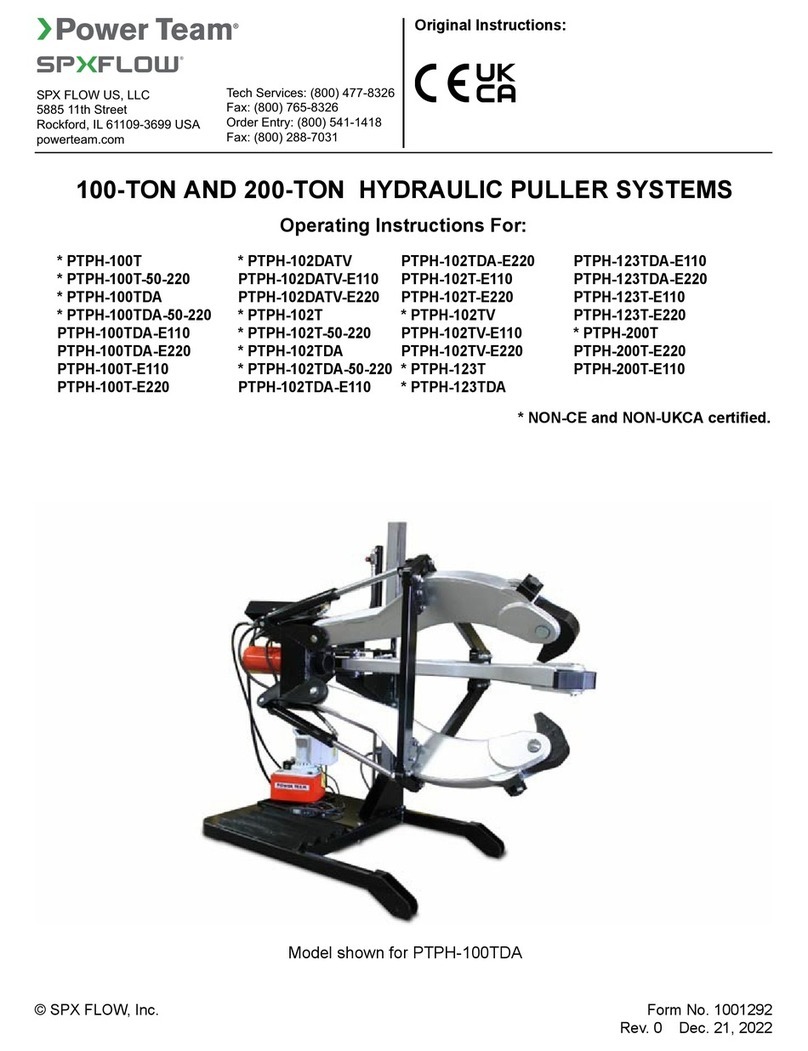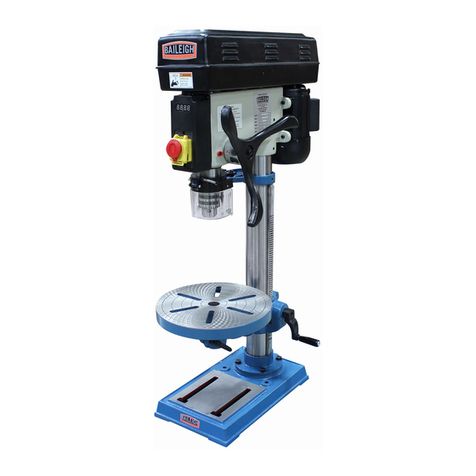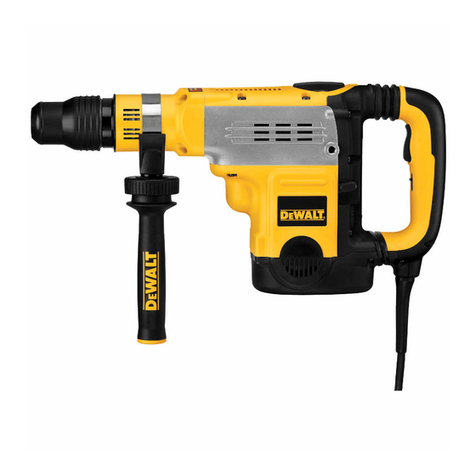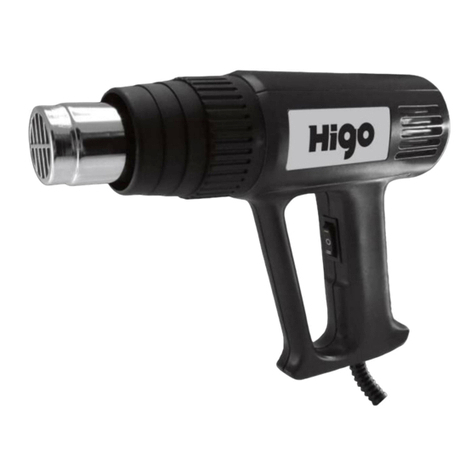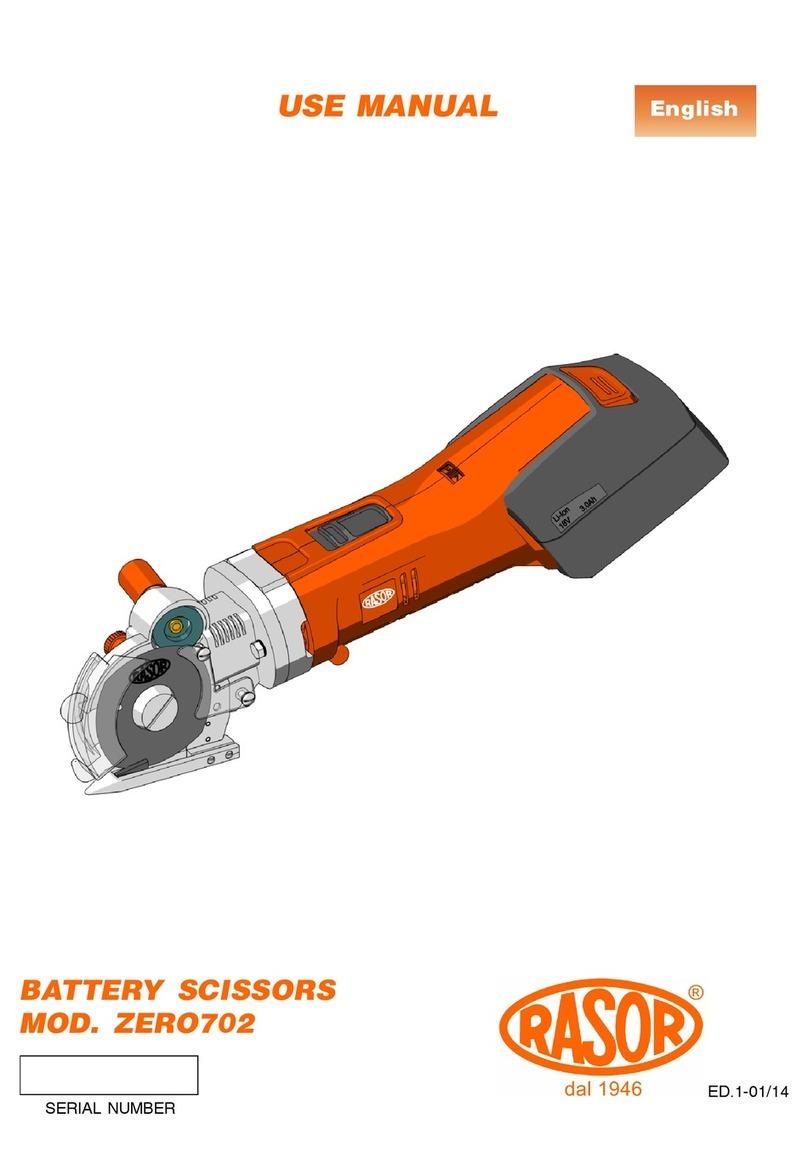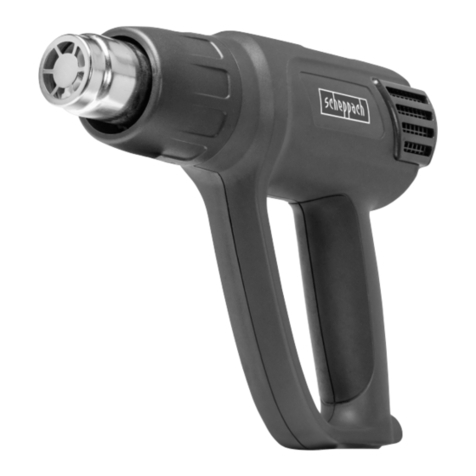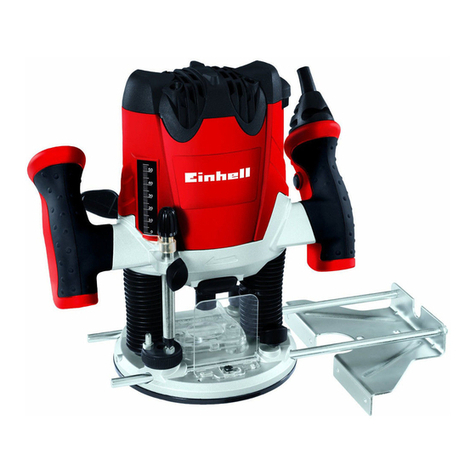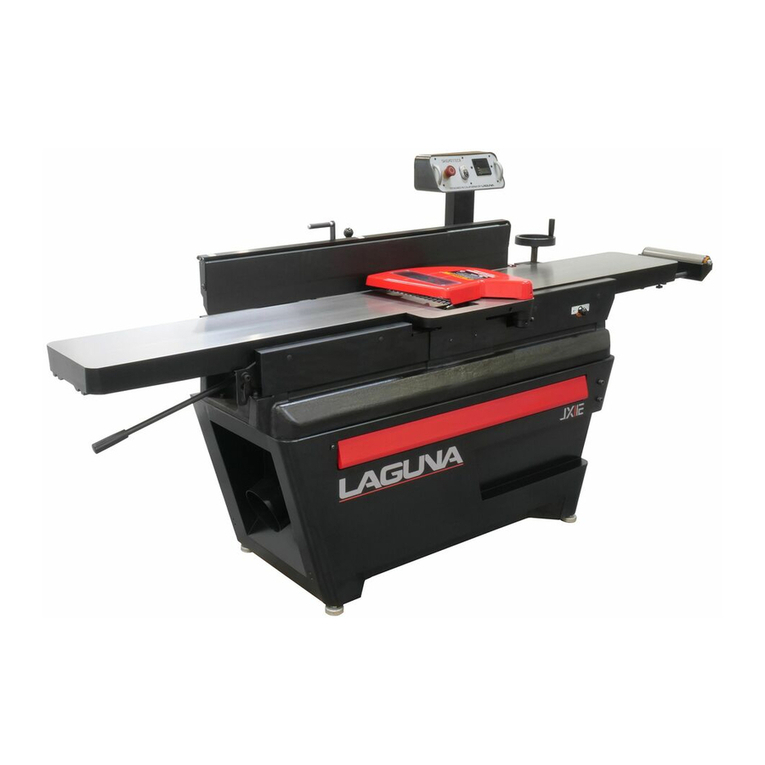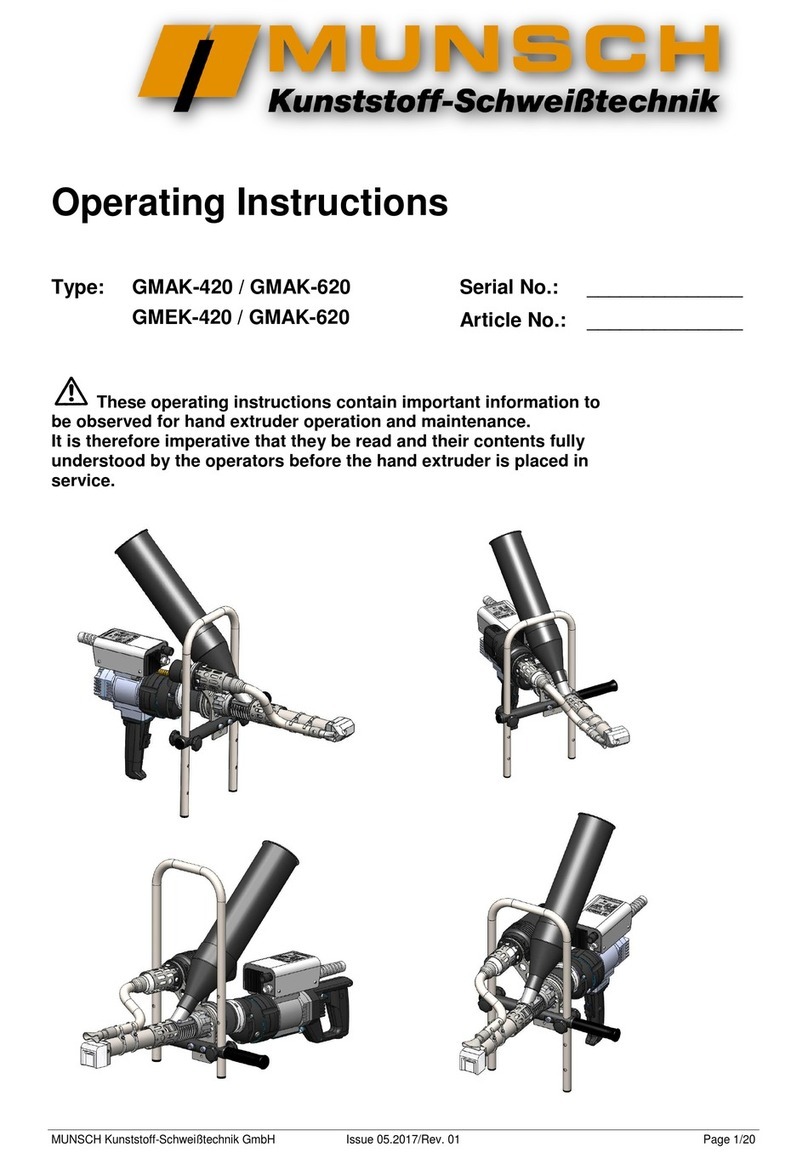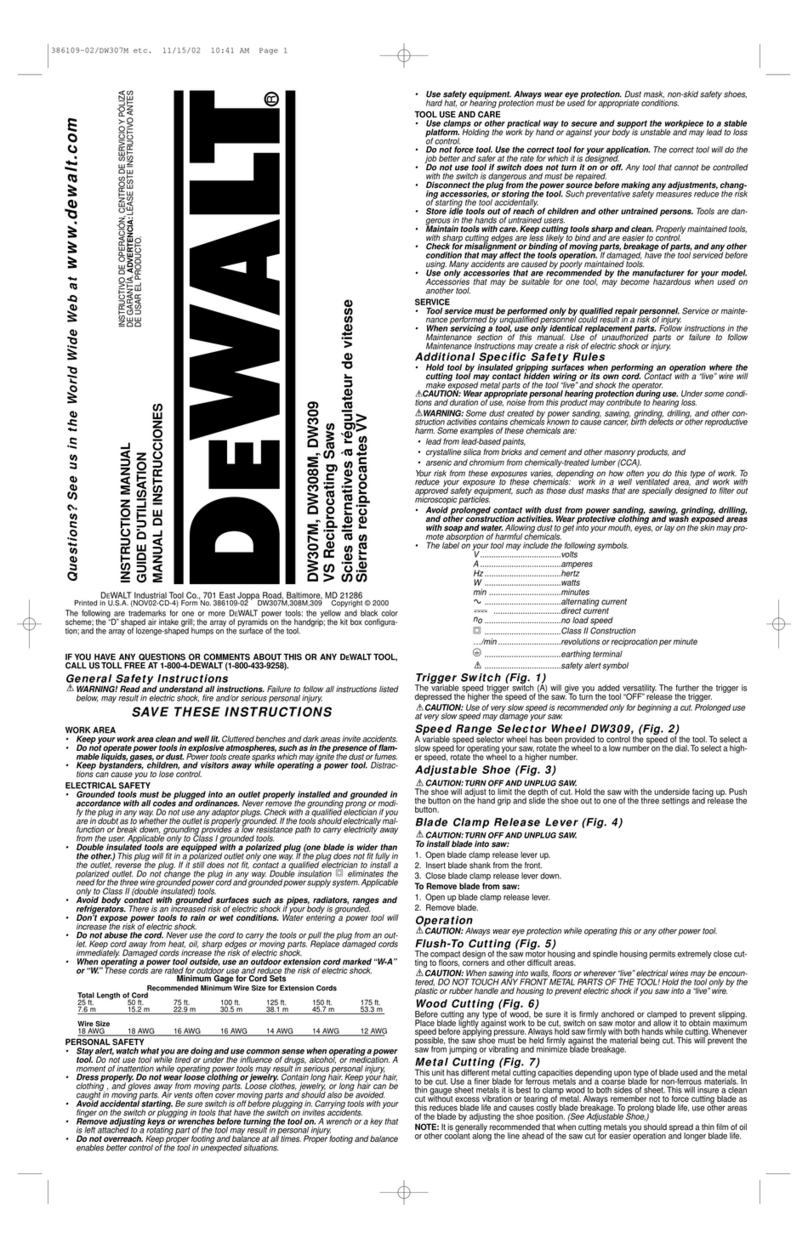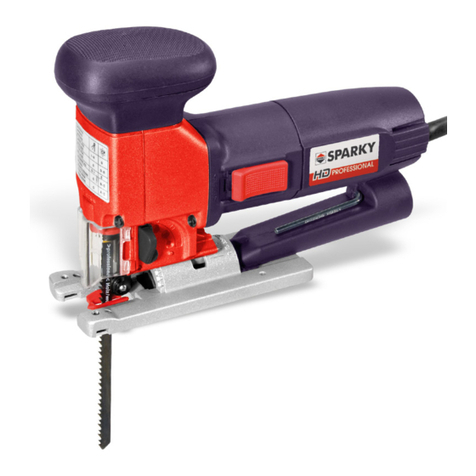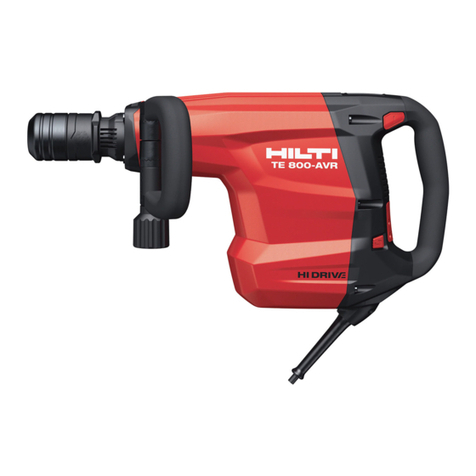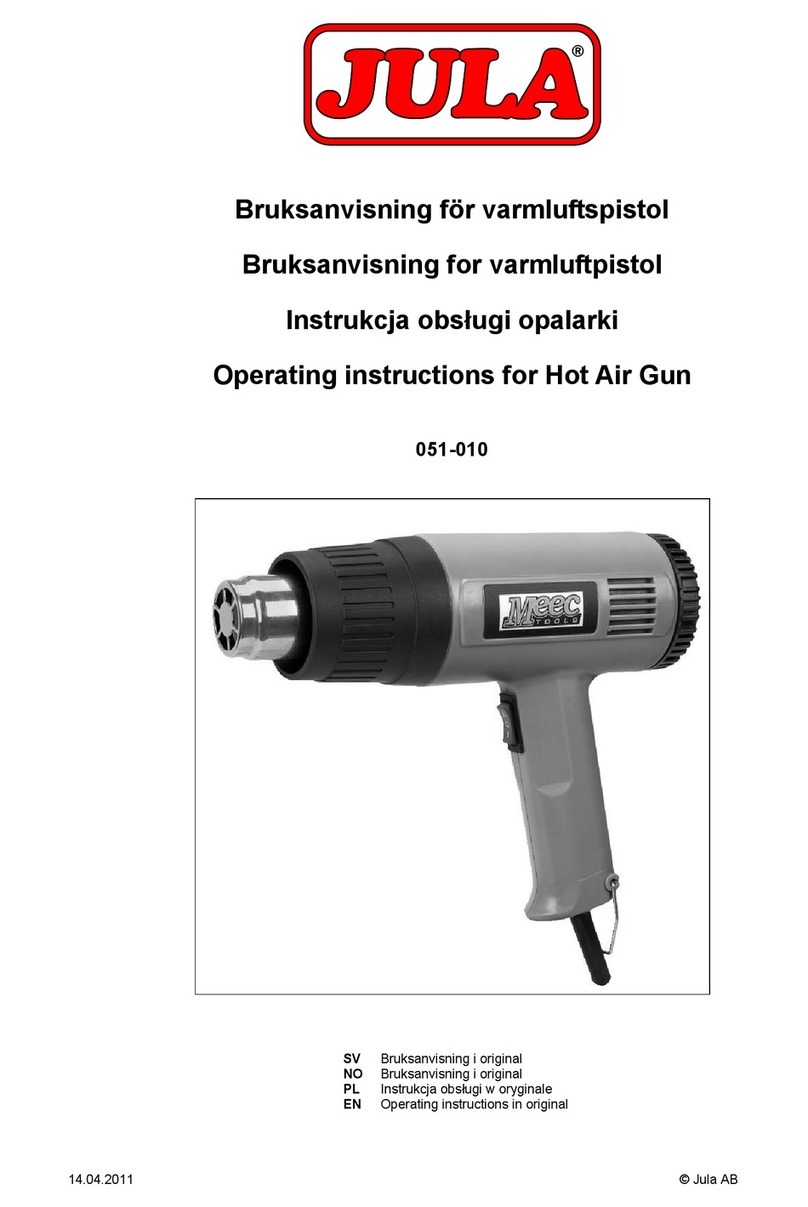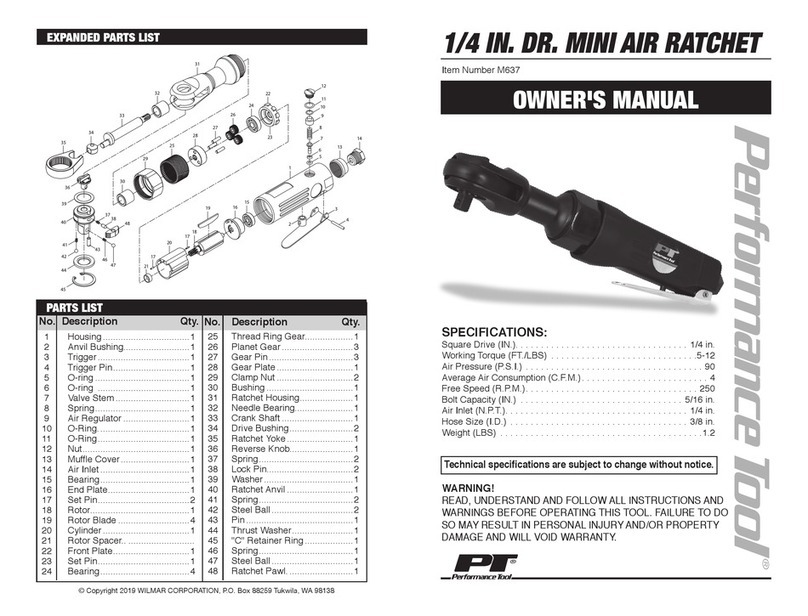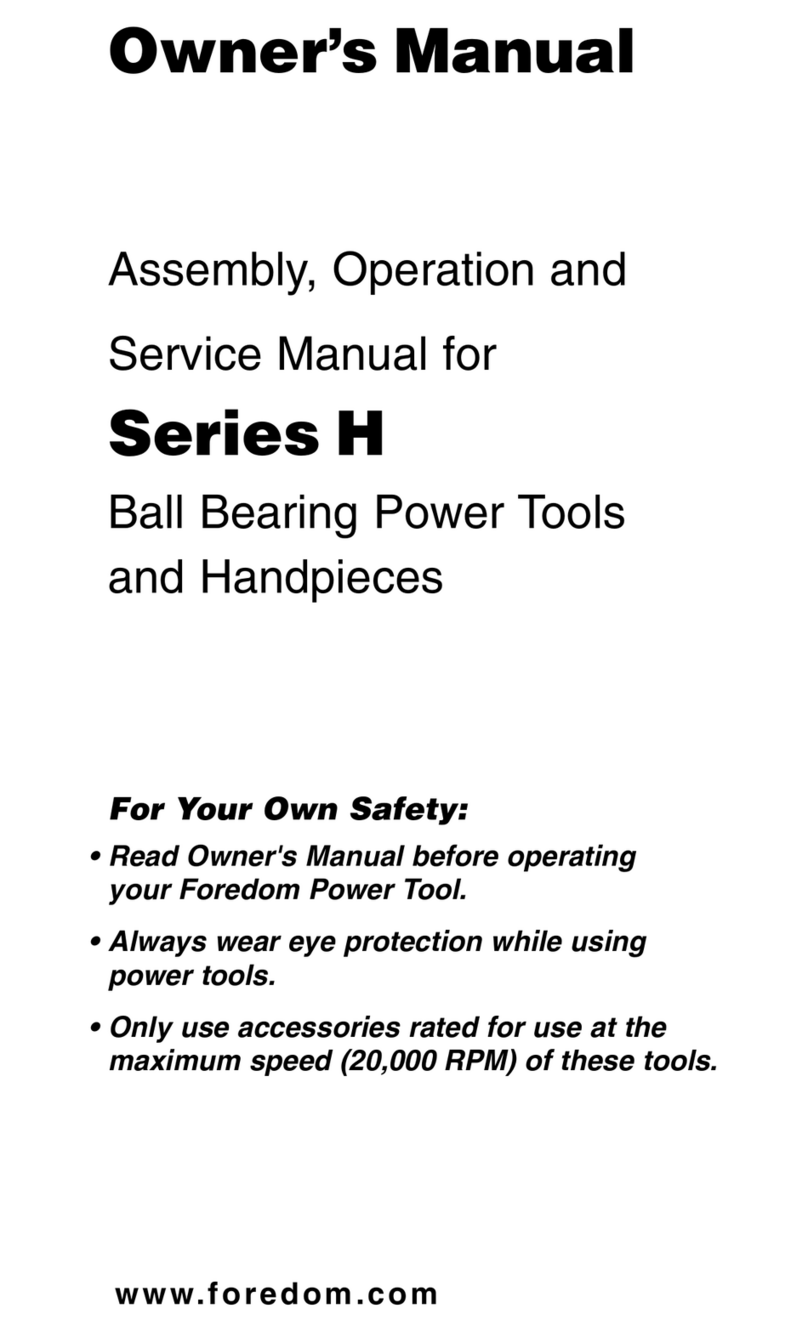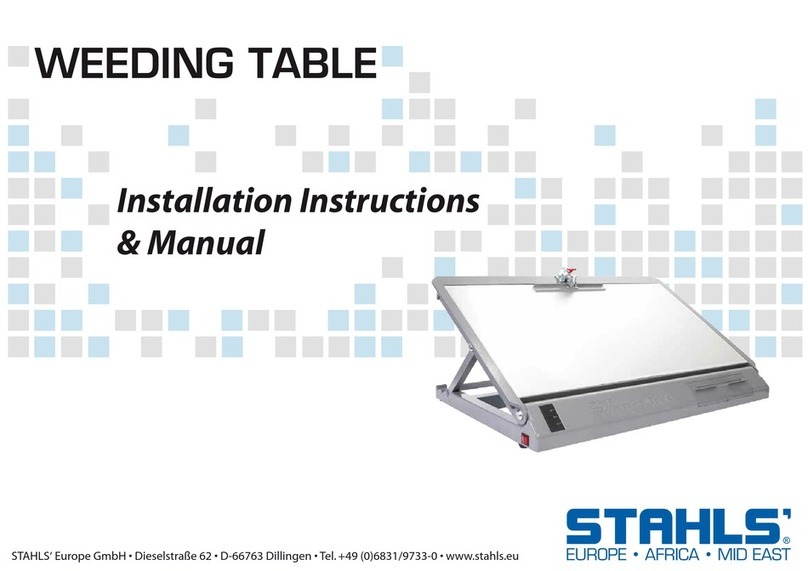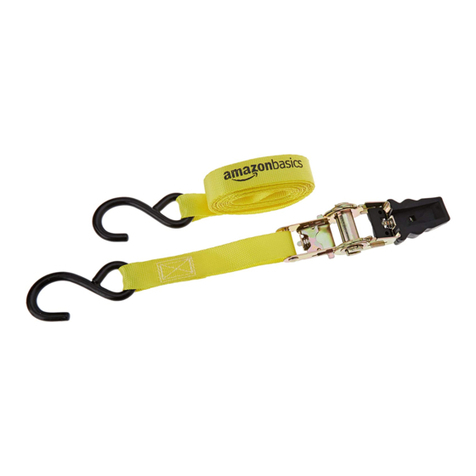SPX FLOW TWHC Series User manual

© SPX FLOW, Inc. Form No. 1000623
Rev. 6 Jan. 10, 2017
High Cycle Hydraulic Torque Wrench
Original Instructions
Unit 4, Wansbeck Business Park
Rotary Parkway
Ashington
Northumberland NE63 8QW
Tel: +44 (0) 1670 850580
Fax: +44 (0) 1670 850655
spxboltingsystems.com
Operating Manual for:
TWHC Series

© SPX FLOW, Inc. Form No. 1000623
Rev. 6 Jan. 10, 2017
Table of Contents
Torque Wrench High Cycle (TWHC)............................................................................................2
Safety Symbols and Denitions...................................................................................................3
Safety Precautions ......................................................................................................................3
Pump ............................................................................................................................... 3
Electric Motor................................................................................................................... 4
Hoses............................................................................................................................... 4
Initial Setup..................................................................................................................................5
Power Requirements ....................................................................................................... 5
Torque Wrench Usage ..................................................................................................... 6
Connecting the System.................................................................................................... 6
Hydraulic Connections..................................................................................................... 6
Use of Sockets................................................................................................................. 6
Safety............................................................................................................................... 7
Preparing the Torque Wrench for Use ............................................................................. 8
Changing the Drive Direction........................................................................................... 8
Setting Torque.................................................................................................................. 8
Operating Instructions ...............................................................................................................10
Positioning the Hydraulic Torque Wrench on the Nut .................................................... 10
Using the Reaction Arm................................................................................................. 10
Reaction Point Safety .....................................................................................................11
Use of Backing Wrenches ..............................................................................................11
Torque Wrench Selection................................................................................................11
Tightening Bolts ..............................................................................................................11
Tightening a Flanged Joint ............................................................................................ 12
Loosening Bolts ............................................................................................................. 12
Performance Specications.......................................................................................................14
Technical Specications................................................................................................. 14
Pressure/Torque Conversion Chart ...........................................................................................15
General Maintenance ................................................................................................................16
Maintenance, Service, and Warranty............................................................................. 16
End of Life and Disposal................................................................................................ 16
Troubleshooting.........................................................................................................................17
Repair Procedures.....................................................................................................................18
Drive Component Disassembly ..................................................................................... 18
Drive Component Assembly .......................................................................................... 20
Multiswivel Manifold Disassembly ................................................................................. 21
Multiswivel Manifold Assembly ...................................................................................... 23
Hydraulic Cylinder Disassembly .................................................................................... 24
Hydraulic Cylinder/Body Assembly................................................................................ 25
Parts Lists................................................................................................................................. 26
TWHC1/3 Torque Wrench Parts List.............................................................................. 26
TWHC6 Torque Wrench Parts List................................................................................. 29
TWHC50 Torque Wrench Parts List............................................................................... 32
EC Declaration of Conformity....................................................................................................35

© SPX FLOW, Inc. Form No. 1000623
Rev. 6 Jan. 10, 2017
Torque Wrench High Cycle (TWHC)
Description: The TWHC torque wrench is a ratchet-type torque tool used in conjunction with
standard impact sockets to hydraulically tighten nuts and bolts. It is powered using a 690 bar
(10,000 psi) hydraulic pump unit. The torque output from the TWHC torque wrench is proportional
to the pump-pressure applied.
Figure 1. TWHC Hydraulic Torque Wrench
1
23
4
5
6
7
Item Description
1 Hydraulic Couplings
2 Multiswivel Manifold
3 Square Drive Release Button
4 Square Drive
5 Reaction Arm Protection Pad
6Reaction Arm
7 Reaction Arm Release Button

© SPX FLOW, Inc. Form No. 1000623
Rev. 6 Jan. 10, 2017
The safety signal word designates the degree or level of hazard seriousness.
DANGER: Indicates an imminently hazardous situation which, if not avoided, will result in death
or serious injury.
WARNING: Indicates a potentially hazardous situation which, if not avoided, could result in death
or serious injury.
CAUTION: Indicates a potentially hazardous situation which, if not avoided, may result in minor
or moderate injury.
CAUTION: Used without the safety alert symbol indicates a potentially hazardous situation which, if not
avoided, may result in property damage.
IMPORTANT: Important is used when action or lack of action can cause equipment failure, either
immediate or over a long period of time.
Safety Symbols and Denitions
WARNING: To prevent personal injury,
• The following procedures must be performed by qualied, trained personnel who
are familiar with this equipment. Operators must read and understand all safety
precautions and operating instructions included with the device. If the operator
cannot read these instructions, operating instructions and safety precautions must
be read and discussed in the operator's native language.
• These products are designed for general use in normal environments. These
products are not designed for use in special work environments such as: explosive,
ammable, or corrosive. Only the user can decide the suitability of this product
in these conditions or extreme environments. SPX Bolting Systems will supply
information necessary to help make these decisions. Consult your nearest SPX
Bolting Systems facility.
• Safety glasses must be worn at all time by the operator and anyone within sight of
the unit. Additional personal protection equipment may include: face shield, goggles,
gloves, apron, hard hat, safety shoes, and hearing protection.
• The owner of this tool must verify that safety-related decals are installed, maintained,
and replaced if they become hard to read.
• Shut OFF the motor before opening any connections in the system.
Pump
WARNING: To prevent personal injury,
• Do not exceed the hydraulic pressure rating noted on the pump nameplate or
tamper with the internal high pressure relief valve. Creating pressure beyond rated
capacities can result in personal injury.
• Retract the system before adding uid to prevent overlling the pump reservoir. An
overll can cause personal injury due to excess reservoir pressure created when
cylinders are retracted.
Safety Precautions

© SPX FLOW, Inc. Form No. 1000623
Rev. 6 Jan. 10, 2017
Electric Motor
WARNING: To prevent personal injury,
• Electrical work must be performed and tested by a qualied electrician per local
directives and standards.
• Disconnect the pump from the power supply and relieve pressure before removing
the motor case cover or performing maintenance or repair.
• Check the total amperage draw for the electrical circuit you will be using. For
example: Do not connect a pump that may draw 25 amps to a 20 amp fused electrical
circuit.
• Never use an ungrounded power supply with this unit.
• Changing the voltage is an involved and, if incorrectly performed, hazardous procedure.
Consult the manufacturer for specic information before attempting rewiring.
• Wire pump motors for counterclockwise rotation when viewed from the shaft end of
the motor.
• Do not attempt to increase the power line capacity by replacing a fuse with another
fuse of higher value. Overheating the power line may result in re.
• Exposing electric pumps to rain or water could result in an electrical hazard.
• Avoid conditions that can cause damage to the power cord, such as abrasion,
crushing, sharp cutting edges, or corrosive environment. Damage to the power cord
can cause an electrical hazard.
Hoses
WARNING: To prevent personal injury,
• Before operating the pump, tighten all hose connections using the correct tools. Do
not overtighten. Connections should be only secure and leak-free. Overtightening
can cause premature thread failure or high pressure ttings to split at pressures
lower than their rated capacities.
• Should a hydraulic hose rupture, burst, or need to be disconnected, immediately
shut off the pump and shift the control valve twice to release pressure. Never
attempt to grasp a leaking hose under pressure with your hands. The force of
escaping hydraulic uid could cause serious injury.
• Do not subject the hose to potential hazard, such as re, sharp surfaces, heavy
impact, or extreme heat or cold. Do not allow the hose to kink, twist, curl, or bend
so tightly that the uid ow within the hose is blocked or reduced. Periodically
inspect the hose for wear, because any of these conditions can damage the hose and
possibly result in personal injury.
• Do not use the hose to move attached equipment. Stress can damage the hose and
possibly cause personal injury.
• Hose material and coupler seals must be compatible with the hydraulic uid used.
Hoses also must not come in contact with corrosive material such as creosote-
impregnated objects and some paints. Consult the manufacturer before painting a
hose. Never paint the couplers. Hose deterioration due to corrosive materials may
result in personal injury.
Safety Precautions continued

© SPX FLOW, Inc. Form No. 1000623
Rev. 6 Jan. 10, 2017
Initial Setup
Each hydraulic torque wrench is supplied completely assembled and ready for use. A hydraulic pump
is required to provide the speed and pressure that makes the hydraulic wrench system efcient and
accurate.
1. Read and understand all instructions before operating the hydraulic torque wrench. It is the operator's
responsibility to read, understand, and follow all safety instructions.
2. Remove the hydraulic torque wrench from the shipping container and visually inspect all components
for any shipping damage. If any damage is found, notify the carrier immediately. DO NOT USE
TOOL.
Power Requirements
The TWHC hydraulic torque wrench requires a hydraulic pump unit, twin-line connecting hose, and
couplings to operate. All components must be capable of operating at the system maximum working
pressure of 690 bar (10,000 psi). Note that the system maximum working pressure is dynamic, not
static.
Pump unit specication varies between manufacturers; however, for correct torque wrench operation,
the pump unit must include the following:
Double Acting—Pump unit must be capable of double acting operation for advancing and retracting
the Torque Wrench.
Variable Pressure Output—For torque setting, the pump unit must be able to be easily adjusted by the
operator for different pressure outputs.
Retract Pressure—Sometimes termed 'idle' pressure, this is the pressure used for torque wrench
retraction and must be xed at approximately 103 bar (1,500 psi). This pressure must not be operator
adjustable.
Remote Handset Controls—The preferred conguration for the handset is such that, upon starting the
pump unit, the pump enters retract or idle mode (pressure xed at 103 bar (1,500 psi)). To advance the
torque wrench, the handset advance/pressure button or lever is pressed and held, upon release of the
button, retract mode is automatically entered. A separate button or lever is used to stop the pump.
Automatic Pressure Release—The pump must automatically release system pressure when switching
between advance and retract modes.
Pump Flow Rate—The speed at which the hydraulic torque wrench operates is proportional to the oil
ow rate. In general, 2-stage pump units are preferred for torque wrench use as this allows rapid nut
rotation under low loads, with fast wrench retraction. As a minimum, 250 cm³/min @ 7 bar (15 ci/min @
100 psi) to 20 cm³/min @ 690 bar (1.2 ci/min @ 10,000 psi) should be specied; however, for optimum
speed and performance, at least 360 cm³/min @ 7 bar (22 ci/min @ 100 psi) to 30 cm³/min @ 690 bar
(1.8 ci/min @ 10,000 psi) is recommended.
Pressure Gauge—Clarity is important for accurate torque setting; therefore, a pressure gauge of at
least 100-mm (4-in.) diameter should be tted.
Hydraulic Couplings—TWHC hydraulic torque wrenches are tted with CEJN 230 screw-to-connect
couplings (1/4-in. NPT) as standard. Verify any couplings that are used are compatible with these
couplings and rated to the same working pressure, e.g. Parker 3000 couplings.
SPX Bolting Systems will not be responsible for torque wrench damage, malfunction or operator injury
caused by the use of an incorrect pump unit; therefore, check the compatibility of your pump unit before
operating the hydraulic torque wrench.

© SPX FLOW, Inc. Form No. 1000623
Rev. 6 Jan. 10, 2017
Torque Wrench Usage
To ensure reasonable life and performance from the torque wrench and system (pump and hoses),
these guidelines should be followed:
• Under normal use, the torque wrench should be limited to 75–80% of its maximum achievable torque
output.
• Under breakout conditions, because the bolt can suddenly break free and result in shock loads,
jumping/jolting, it is recommended to limit the wrench output torque to 60–70% of maximum
achievable torque output. It is also a good idea to have torque in reserve for the odd stubborn bolt/
nut.
• Once a corroded bolt has broken free, do not use a torque wrench to wind the nut from the bolt. This
can cause the nut to bind and lock onto the bolt and make it impossible to remove. It is preferred
that a nut runner or impact wrench be used to remove the nut following initial breakout by hydraulic
torque wrench.
• Occasional use of the torque wrench at full pressure/torque is acceptable, but unnecessary
continuous use at full pressure will reduce the life of the torque wrench and system.
• In elevated temperature environments, it is advisable to cool the torque wrench as much as practical
to maintain the sealing systems in good order. Depending upon the pressure applied to the wrench,
repeated use in temperatures in excess of 40°C (104°F) will affect the life of the hydraulic seals.
If the temperatures are likely to exceed 40°C (104°F), it is advisable to use a larger capacity wrench
so that the pressure to achieve the required torque is reduced. This will result in less temperature
buildup and less softening of the seals.
Seals should be replaced regularly because, at elevated temperatures, the extrusion resistance of
the seal is reduced.
Connecting the System
The hydraulic wrench head and power pack are connected by a 690 bar (10,000 psi) twin-line hose
assembly. Refer to the power-unit manufacturer's operating instructions for proper use.
Hydraulic Connections
• Never connect or disconnect any hydraulic hoses or fittings without first unloading the
wrench and the pump.
• Open all hydraulic controls several times to verify the system has been completely
depressurized.
• If the system includes a gauge, double check the gauge to verify pressure has been
released.
• When making connections with quick-disconnect coupling, verify the couplings are fully
engaged. Threaded connections such as fittings, gauges, etc., must be securely tightened
and leak-free.
Use of Sockets
Use high-quality, industrial impact sockets at all times. Verify that sockets are rated to accept the full
torque output of the torque wrench they are used with. Regularly check the socket for cracks and aws.
If any sign of damage is evident, discard immediately. A damaged socket breaking under load can
cause equipment damage or operator injury.
Initial Setup continued

© SPX FLOW, Inc. Form No. 1000623
Rev. 6 Jan. 10, 2017
Long-reach or deep sockets are not recommended for use with hydraulic torque tools because they
can make the wrench and socket unstable. However, some applications demand the use of long-reach
sockets. When long-reach sockets are used, support for both the socket and reaction facility must
be provided. The same applies to socket accessories, such as extension bars, knuckle joints (not
recommended), etc.
Safety
The TWHC hydraulic torque wrench is a high-power hydraulic tool. It is strongly recommended that
all users are fully trained and competent in the use of hydraulic torque wrench systems. Incorrect use
of the equipment or failure to follow any of the safety precaution included herein could lead to serious
injury.
NOTE: The TWHC torque wrench is designed for torque tightening of engineering nuts only. Do
not use it for any other purpose.
• Never exceed the hydraulic torque wrench maximum working pressure of: Advance 690 bar (10,000
psi) and Retract 103 bar (1,500 psi).
• Keep hands and fingers clear of the hydraulic torque wrench head and reaction pad area, before and
during operation.
• Keep other personnel clear of the working area and only allow trained personnel to use the
equipment.
• Before operation, verify all hoses and equipment are in proper working order. Verify all hydraulic
torque wrench components (i.e. square drive, reaction arm, etc.) are properly attached and secure.
Verify the square drive retainer button is properly located.
• Do not strike any of the components, including the socket, to shock the nut free.
• Verify reaction structures are strong and rigid enough to accept the torque tool reaction forces. Do
not use wedges, packing pieces, etc. as temporary reaction structures.
• If backing wrenches are used, keep hands and limbs well clear of the backing wrench.
• Do not tighten any equipment while under pressure. Do not move or rotate the multiswivel manifold
while under pressure.
• Verify that any sockets to be used with the hydraulic torque wrench are of impact quality and capable
of withstanding the full torque output of the tool.
• Some hydraulic torque wrenches weigh in excess of 20 Kg (44 lb). If necessary, lifting equipment
can be used.
• In some instances, it may be necessary for the operator to support the hydraulic torque wrench while
it is tightening, i.e. upside-down operations. If the hydraulic torque wrench cannot be strapped into
position using ropes, etc., the operator must take care to avoid pinch points.
• Verify hoses are in good condition and undamaged. Do not bend hoses beyond their safe bend
radius limit or kink the hose.
• Never use the hydraulic torque wrench with just one hose connected to the Advance port (Port A).
This will cause the pressure to intensify within the retract chamber possibly leading to tool damage.
Always verify that both hoses are correctly connected.
• Take care when handling equipment. Quick connect couplings are especially susceptible to knocks
and damage and therefore care must be taken. Note that damaged couplings are difficult to connect.
Do not force couplings.
Initial Setup continued

© SPX FLOW, Inc. Form No. 1000623
Rev. 6 Jan. 10, 2017
Initial Setup continued
• Do not strike, misuse or abuse any of the equipment. If any abuse or misuse of the equipment is
evident, the warranty shall be invalid and the Manufacturer shall not be responsible for any injuries
or failures as a result.
• If not in use, and when practical, disconnect the wrench and pump from the power supply to prevent
accidental starting.
Preparing the Torque Wrench for Use
IMPORTANT: For a copy of the calibration certificate for a specific hydraulic torque wrench,
CAUTION: For top performance, frequently inspect wrench, pump, and accessories for visual
damage. Always follow instructions for proper wrench and pump maintenance. Do not use other
equipment to increase the capability (i.e., hammering on socket wrench).
Changing the Drive Direction
To change the drive direction:
1. Press and hold the drive-release button and pull out the square drive. The square drive, retainer cap,
and button assembly are now free.
2. To reinstall, insert the square drive into the opposite side of the tool head, aligning the splines, and
replace the retainer cap assembly.
3. Pull the square drive to verify that it is locked in position.
1
2
Item Description
1 Square Drive Release Button
2 Square Drive Cap
Figure 2. Square Drive Operation
Setting Torque
1. Verify the system is fully connected and the proper power supply is available.
2. Refer to the Pressure/Torque Conversion Chart in the Performance Specications section. Note that
this pressure is set on the pump.
3. Turn on the pump.
4. Press and hold the remote control button.

© SPX FLOW, Inc. Form No. 1000623
Rev. 6 Jan. 10, 2017
5. Check the pressure on the gauge.
6. Increase or decrease pressure as required. Refer to pump manufacturer's operating instructions.
7. Before tightening a nut, press the remote control button and conrm the correct pressure has been
set.
8. Verify that the bolt threads, nut threads, and nut-to-ange contact faces are liberally coated with anti-
seize lubricant of the same friction coefcient used to derive the torque value.
9. Make sure the hydraulic torque wrench is suitable to deliver the required torque. Should the torque
value exceed 80% of the hydraulic torque wrench output, consider using a higher capacity hydraulic
torque wrench.
10. Use the Pressure/Torque Conversion Chart in this manual to obtain the required pump pressure.
11. Verify that the socket to be used is of the correct type and size. A poor tting or oversized socket can
damage nuts, induce inaccurate bolt loads, and may result in operator injury.
12. Place the proper size impact socket on the square drive and secure it properly with the locking ring
and pin. Verify that the square drive is fully engaged into the socket.
13. Verify that the reaction arm is placed rmly against a stationary object such as an adjacent nut,
ange, equipment housing, etc.
NOTE: When positioning the wrench, verify the hose connection will not hit any
stationary object, which can result in snapping a hose connection or breaking the
coupler connection.
NOTE: TWHC torque wrenches are equipped with a pressure-release valve built into
the multiswivel manifold to protect against retract pressure intensification should the
retract port hydraulic coupling not be fully connected or become loose during use. If
an intensification occurs, the valve will bleed hydraulic oil externally from the manifold
yoke. Oil bleeding from the swivel manifold is not a sign of seal leakage.
14. Before applying the hydraulic torque wrench to the application, the pump output pressure must be
preset to relieve at the pressure obtained from the Pressure/Torque Conversion Chart. This can be
done with the hydraulic torque wrench connected to the pump and resting on the oor or bench.
Applying advance pressure to the hydraulic torque wrench will extend the piston until it reaches the
end of its stroke whereby the pump pressure will build. Holding the wrench at the end of its stroke
will allow the pump pressure to be adjusted. Retract the hydraulic torque wrench piston and advance
again making sure that the pump relieves at the desired pressure setting. The pump pressure can
also be set by blanking the pump outlets using blank couplings.
NOTE: Allow time for the wrench to retract. If another advance stroke is made before
the torque wrench has fully retracted, the ratchet mechanism may not engage correctly,
causing it to jump a ratchet tooth, and possibly damaging the ratchet. Before applying
another advance stroke, make sure the pump is idling at 103 bar (1,500 psi), which
indicates full retraction.
Initial Setup continued

© SPX FLOW, Inc. Form No. 1000623
Rev. 6 Jan. 10, 2017
Operating Instructions
Positioning the Hydraulic Torque Wrench on the Nut
Figure 3 indicates correct position of the hydraulic torque wrench (shown in tightening mode). Always
verify that the reaction pad braces rmly against an adjacent nut or secure reaction structure.
Using the Reaction Arm
See Figure 3. The TWHC hydraulic torque wrench features a 360° adjustable reaction arm. Although
the reaction arm can be placed in a multitude of positions, always try to use the torque tool with the
reaction arm positioned parallel to the socket (i.e. 90° to the torque tool body).
NOTE: Always verify that the reaction arm is locked onto the body before use, and never
attempt to unlock and slide the reaction arm part way off the body to facilitate a reaction
point out of reach of its engaged position.
1
2
Item Description
1 Socket
2 Reaction Arm Parallel to Socket and Braced Firmly Against Flange Nut
Figure 3. Correct Reaction Arm Positioning

© SPX FLOW, Inc. Form No. 1000623
Rev. 6 Jan. 10, 2017
Reaction Point Safety
Follow these guidelines when selecting appropriate reaction points:
• The reaction structure must be rigid enough to accommodate the forces from the hydraulic torque
wrench. Carefully inspect the reaction points for suitability before applying the torque tool. If in doubt,
contact the torque wrench supplier for advice.
• Tapered surfaces are generally unsuitable as the torque wrench tends to 'ride up' the taper, causing
adverse tool loads. Flat surfaces are preferred.
• Packing pieces, spacers, etc. must never be used as a makeshift reaction point. Reaction
accessories are available to increase the access to reaction points.
Use of Backing Wrenches
Backing wrenches are often used to prevent the non-tightening nut on the opposite side of the joint
assembly from turning during the torquing operation. Verify that the backing wrench is the correct
size and securely fastened in position (using straps, ropes, etc.). As the torquing operation begins, it
is normal for the backing wrench to move/rotate in conjunction with the torqued nut, until the backing
wrench contacts an adjacent reaction point. It is important that the operator stand clear of the moving
backing wrench to prevent accidental entrapment. The operator must also verify that the reaction point
is secure and sufciently rigid to prevent damage to the structure.
Torque Wrench Selection
To choose the correct capacity Torque Wrench for the application, the estimated break-out torque
should be considered, not the tightening torque. Loosening bolts usually requires a higher torque, and if
a wrench has been selected on tightening criteria only, it will seldom perform in a break-out situation.
Break-out Considerations
Nuts / Bolts which have been correctly lubricated at the make-up / tightening stage will require
approximately 1.5 x tightening torque to loosen following a period of service, PROVIDED THEY HAVE
NOT BEEN SUBJECTED TO HEAT.
Corroded / rusted bolts, and bolts without lubrication applied at make-up, will require approximately 2 x
tightening torque to loosen. PROVIDED THEY HAVE NOT BEEN SUBJECTED TO HEAT.
Nuts / bolts subjected to heat, seawater corrosion, chemical corrosion, can require 3 to 4 x tightening
torque.
Before selecting a torque wrench for the application, ensure that the above has been considered.
Tightening Bolts
1. Apply the torque wrench and socket to the nut to be tightened, verifying that the reaction arm rmly
and squarely contacts the selected reaction point.
2. Start the pump and advance the hydraulic torque wrench. As the wrench strokes forward, the reaction
pad will press against the reaction point and the socket will rotate. When the hydraulic torque wrench
reaches the end of its stroke, the pump pressure will build rapidly. Fully retract the hydraulic torque
wrench (the wrench ratchet mechanism will be heard clicking as it retracts), and apply another
forward stroke.
3. Several forward strokes are made until the nut ceases to rotate during the stroke (known as stalling),
but bear in mind that nut rotation will always cease at the end of the wrench stroke and must not be
confused with the wrench stalling. When the wrench stalls, apply another forward stroke and observe
the pump pressure gauge. The pump pressure gauge should read the desired preset pressure.
4. Retract the hydraulic torque wrench, stop the pump unit, and remove the wrench from the nut.
Operating Instructions continued

© SPX FLOW, Inc. Form No. 1000623
Rev. 6 Jan. 10, 2017
Tightening a Flanged Joint
This procedure outlines the basic steps to torque-tighten a anged joint with a TWHC hydraulic
torque wrench. It is important that personal protective equipment (gloves, footwear, safety helmet,
eye protection, etc.) is worn at all times by the operator and any other personnel in the work area.
The torquing procedure uses a single hydraulic torque wrench to accurately achieve a predetermined
residual bolt stress.
WARNING: Before bolt torquing, verify that:
• The procedure and data to be used is authorized by a responsible engineer.
• The joints/pipework being worked on are not live. Joints must be at zero pressure and free
from hazardous substances.
• The torque value selected must be based upon the lubricant applied.
Procedure
1. Working in a crisscross pattern, number each bolt in order of torque sequence.
2. Square up the anged joint using hydraulic torque wrenches, if necessary.
3. Set the pump at its lowest possible output, 103 bar (1,500 psi), and following the numbers on the
bolts, apply the minimum torque to the bolts.
4. In the same tightening sequence, apply approximately 25% of the torque value specied in the
torque data.
5. In the same tightening sequence, apply approximately 50% of the torque value specied in the
torque data.
6. In the same tightening sequence, apply the full torque value specied in the torque data.
7. Working in a clockwise (or counter-clockwise) direction, make a nal pass around the ange,
tightening each bolt to the full torque value specied in the torque data.
8. Using a hammer, “ring” each nut to verify that each bolt has been correctly loaded and that no slack
bolts remain.
Loosening Bolts
Loosening bolts using hydraulic torque wrenches can be unpredictable and often unsuccessful,
especially if the nuts and bolts are severely corroded. However, some measures can be carried out to
increase the success rate of nut breakout:
• In general, loosening mildly rusted bolts requires up to twice the makeup torque to release the nut.
Heavily corroded bolts may take up to three times the makeup torque. Verify that the bolt and nut
material is strong enough to accept these higher torques.
• Remove surface rust and scale using a wire brush. Apply releasing oil to the nut, bolt, and bearing
face, and allow time for the release oil to soak in and penetrate.
• Only use the hydraulic torque wrench to break the nut free. Using the torque tool to wind the nut
from the bolt can induce high torsion and reaction forces. Therefore, it is better to use an impact
wrench to completely remove the nut.
• Never strike the torque wrench or nut/bolt in an attempt to 'shock' the nut free. This can cause
damage to the hydraulic torque wrench and operator injury. Evidence of torque wrench abuse will
void the Manufacturer's Warranty.
NOTE: Should maximum pump pressure be reached, and the nut has not broken free,
use a higher capacity hydraulic torque wrench (if the nut/bolt material will accept the
Operating Instructions continued

© SPX FLOW, Inc. Form No. 1000623
Rev. 6 Jan. 10, 2017
higher torques without damage). Do not, under any circumstances, strike the hydraulic
torque wrench or nut/bolt in an attempt to 'shock' the nut free.
Procedure
1. Connect the hydraulic torque wrench to the pump unit. Verify that the couplings are fully screwed
together; they are self-sealing and will restrict oil ow if not fully connected.
2. Before applying the hydraulic torque wrench to the application, the pump output pressure must be
preset to deliver the maximum pressure of 690 bar (10,000 psi). This can be done with the torque
wrench connected to the pump and resting on the oor or bench. Applying advance pressure to the
hydraulic torque wrench will extend the piston until it reached the end of its stroke whereby the pump
pressure will build. Holding the wrench at the end of its stroke will allow the pump pressure to be
adjusted. Retract the hydraulic torque wrench piston and advance again making sure that the pump
delivered full pressure. The pump pressure can also be set by blanking the pump outlets using blank
couplings.
3. Apply the hydraulic torque wrench and socket to the nut to be loosened and verify that the reaction
pad is braced rmly and squarely against the selected reaction point.
4. Start the pump and advance the hydraulic torque wrench. As the wrench strokes forward, the reaction
pad will press against the reaction point. As the pump pressure builds (and torque is applied to the
nut), the nut will break free. Once the nut has been released, remove the nut by hand if loose enough,
or alternatively use an impact wrench. Using the hydraulic torque wrench is not recommended.
NOTE: Should maximum pump pressure be reached, and the nut has not broken free,
use a higher capacity hydraulic torque wrench (if the nut/bolt material will accept the
higher torques without damage). Do not, under any circumstances, strike the hydraulic
torque wrench or nut/bolt in an attempt to 'shock' the nut free.
5. Retract the hydraulic torque wrench, stop the pump unit, and remove the wrench from the nut.
Operating Instructions continued

© SPX FLOW, Inc. Form No. 1000623
Rev. 6 Jan. 10, 2017
Performance Specications
Technical Specications
The following technical data is applicable to all TWHC hydraulic torque wrenches:
MAXIMUM PRESSURE: Advance - 690 bar (10,000 psi)
Retract - 103 bar (1,500 psi)
OPERATING TEMPERATURE LIMITS: -20°C to +40°C (-4°F to 104°F)
HYDRAULIC OIL TYPE: Grade 46 hydraulic oil
Wrench Ref Square Drive, mm (in.) Torque Output, ft-lb Approximate
Weight, kg (lb)
MIN** MAX
TWHC1 19.05 (3/4) 170 1,413 2.8 (6.2)
TWHC3 25.4 (1) 376 3,136 5.3 (11.7)
TWHC6 38.1 (1 1/2) 726 6,050 8.8 (19.4)
TWHC50 63.5 (2 1/2) 6360 53000 69.0 (152.0)
** Note that minimum torque can be lower depending upon pump low-pressure capability

© SPX FLOW, Inc. Form No. 1000623
Rev. 6 Jan. 10, 2017
Pressure/Torque Conversion Chart
Pump
Pressure
Torque Output
TWHC1 TWHC3 TWHC6 TWHC50
bar psi Nm ft-lb Nm ft-lb Nm ft-lb Nm ft-lb
83 1200 230 170 510 376 984 726 8618 6360
97 1400 268 198 595 439 1148 847 10054 7420
110 1600 306 226 680 502 1312 968 11491 8480
124 1800 345 254 765 564 1476 1089 12927 9540
138 2000 383 283 850 627 1640 1210 14363 10600
152 2200 421 311 935 690 1804 1331 15799 11660
165 2400 460 339 1020 753 1967 1452 17236 12720
179 2600 498 367 1105 815 2131 1573 18672 13780
193 2800 536 396 1190 878 2295 1694 20108 14840
207 3000 574 424 1275 941 2459 1815 21545 15900
221 3200 613 452 1360 1004 2623 1936 22981 16960
234 3400 651 480 1445 1066 2787 2057 24417 18020
248 3600 689 509 1530 1129 2951 2178 25854 19080
262 3800 728 537 1615 1192 3115 2299 27290 20140
276 4000 766 565 1700 1254 3279 2420 28726 21200
290 4200 804 593 1785 1317 3443 2541 30163 22260
303 4400 842 622 1870 1380 3607 2662 31599 23320
317 4600 881 650 1955 1443 3771 2783 33035 24380
331 4800 919 678 2040 1505 3935 2904 34472 25440
345 5000 957 707 2125 1568 4099 3025 35908 26500
359 5200 996 735 2210 1631 4263 3146 37344 27560
372 5400 1034 763 2295 1693 4427 3267 38780 28620
386 5600 1072 791 2380 1756 4591 3388 40217 29680
400 5800 1110 820 2465 1819 4755 3509 41653 30740
414 6000 1149 848 2550 1882 4919 3630 43089 31800
427 6200 1187 876 2635 1944 5083 3751 44526 32860
441 6400 1225 904 2720 2007 5247 3872 45962 33920
455 6600 1264 933 2805 2070 5411 3993 47398 34980
469 6800 1302 961 2890 2132 5575 4114 48835 36040
483 7000 1340 989 2975 2195 5738 4235 50271 37100
496 7200 1379 1017 3060 2258 5902 4356 51707 38160
510 7400 1417 1046 3144 2321 6066 4477 53144 39220
524 7600 1455 1074 3229 2383 6230 4598 54580 40280
538 7800 1493 1102 3314 2446 6394 4719 56016 41340
552 8000 1532 1130 3399 2509 6558 4840 57453 42400
565 8200 1570 1159 3484 2572 6722 4961 58889 43460
579 8400 1608 1187 3569 2634 6886 5082 60325 44520
593 8600 1647 1215 3654 2697 7050 5203 61762 45580
607 8800 1685 1243 3739 2760 7214 5324 63198 46640
621 9000 1723 1272 3824 2822 7378 5445 64634 47700
634 9200 1761 1300 3909 2885 7542 5566 66070 48760
648 9400 1800 1328 3994 2948 7706 5687 67507 49820
662 9600 1838 1356 4079 3011 7870 5808 68943 50880
676 9800 1876 1385 4164 3073 8034 5929 70379 51940
689 10000 1915 1413 4249 3136 8198 6050 71816 53000
700 10153 1944 1435 4314 3184 8323 6142 72912 53809

© SPX FLOW, Inc. Form No. 1000623
Rev. 6 Jan. 10, 2017
General Maintenance
Maintenance
Maintenance should follow each period of use to keep the TWHC hydraulic torque wrench in good
working condition.
TWHC Hydraulic Torque Wrench
1. Wipe away any debris that may have accumulated, particularly around the square-drive area, reaction
arm, and hydraulic couplings.
2. Inspect the following components:
• Hydraulic couplings for signs of damage.
• Swivel manifold to verify the retaining ring is present and tted correctly.
• Verify the guard is present and securely attached. Replace/reattach as necessary.
3. Remove the square drive from the torque wrench and inspect for damage, cracks, etc. Lubricate the
bearing journals using Revol R5 Moly Anti-Seize, and replace the square drive.
NOTE: The TWHC torque wrench drive components must be lubricated using the
specified product only. Using alternative lubricants will affect the torque wrench and
might lead to premature component failure.
4. Lightly spray the hydraulic torque wrench with water repellent spray before placing in storage.
Drive components should be lubricated at regular intervals depending on usage. Refer to the repair
procedures section for instructions.
Hoses
1. Clean and inspect each hydraulic hose and quick-connect coupling. Check the entire length of the
hose for cuts, abrasions, and damage. Replace the entire hose if any evidence of damage is present.
2. Coat each quick-connect coupling with a water repellent spray.
Maintenance, Service, and Warranty
In addition to post-use maintenance, and to ensure that the Product Warranty remains valid, it is
recommended that routine maintenance and servicing be carried out by the Manufacturer or Authorised
Service Centre.
Maintenance and servicing should be carried out in accordance with the manufacturers ‘ Equipment
Maintenance and Servicing Manual’.
All TWHC torque wrenches are supplied under the Manufacturers’ standard terms and conditions.
All components shall be guaranteed for a period of twelve months from the date of purchase against
material defects and workmanship. All components shall be guaranteed for a period of twelve months
from the date of purchase against defects arising from normal use, with the following exclusions:
• Hydraulic seals and back-up rings • Springs
• Bushes and bearings • Circlips
• O-ring seals • Paints and coatings
• Quick-disconnect couplings • Plastic screws and plugs
• Labels and decals
End of Life and Disposal
In accordance with our End of Life Policy, should the product be no longer required for use, it should be
returned to SPX Bolting Systems where it shall be disposed of in a safe and environmentally friendly
manner.

© SPX FLOW, Inc. Form No. 1000623
Rev. 6 Jan. 10, 2017
Troubleshooting
Fault Possible Cause Remedy
Cylinder will not advance.
Cylinder will not retract.
1. Coupling not fully mated.
2. Cylinder seal leakage.
3. Pump unit.
4. Faulty coupling.
1. Check coupling.
2. Replace seal.
3. Check pump unit.
4. Replace coupling.
Torque wrench operates
backwards.
1. Reversed couplings. 1. Check pump, hose, and
torque wrench for cross
connection.
Pressure will not build. 1. Cylinder seal leakage.
2. Swivel seal leakage.
3. Defective pump unit.
1. Change seals.
2. Change seals.
3. Check pump unit.
Pressure builds, but wrench
does not move.
1. Hose restriction.
2. Coupling not fully
assembled.
1. Change hose.
2. Fully tighten coupling.
Slow torque wrench operation. 1. Hose restriction.
2. Coupling not fully
assembled.
3. Pump ow rate too small.
1. Change hose.
2. Fully tighten coupling.
3. Use higher ow pump.
Erratic or slow retraction
speed.
1. Hose restriction.
2. Coupling not fully
assembled.
1. Change hose.
2. Fully tighten coupling.
Torque wrench does not
ratchet.
1. Broken drive shoe.
2. Jammed drive shoe.
3. Damaged ratchet.
1. Replace drive shoe.
2. Check drive shoe and
spring.
3. Check/replace ratchet.
Ratchet jumps while driving. 1. Worn/damaged ratchet.
2. Worn/damaged drive shoe.
3. Wrench incorrectly
retracted.
4. Weak/snapped drive shoe
spring.
1. Replace ratchet and drive
shoe.
2. Replace ratchet and drive
shoe.
3. Allow time to fully retract.
4. Replace springs.
Difculty in hose connection. 1. Pressure within hose.
2. Damaged coupling.
1. Vent hose.
2. Replace coupling.
General Maintenance continued

© SPX FLOW, Inc. Form No. 1000623
Rev. 6 Jan. 10, 2017
It is recommended that full servicing is carried out on an annual basis by the manufacturer or approved
service agent (other than maintenance, lubrication, and emergency seal replacement). All components
shall be inspected and critical components subjected to nondestructive testing. Hydraulic torque
wrenches will be pressure tested and issued with test certication.
Although it is possible to disassemble the TWHC hydraulic torque wrench on site, it is recommended
that this operation be carried out in a clean workshop environment, as dirt and debris can severely
affect the performance of the seals and other components. Eye protection should be worn at all times
during tool assembly and disassembly.
General servicing/repair can be carried out in three specic areas of the hydraulic torque wrench. This
allows servicing and lubricating of specic components without complete stripdown. The three servicing
areas are:
• Drive components and lubrication.
• Multiswivel manifold components.
• Hydraulic cylinder components.
Full servicing indicates that all three areas are
serviced.
Drive Component Disassembly
The drive components should be lubricated at regular
intervals, typically every three months for normal use
but monthly or even weekly for frequent/prolonged use.
Component lubrication is carried out as follows.
1. Verify the torque wrench is fully retracted. Disconnect
the power supply.
2. See Figure 4. Remove the guard, unscrewing the
guard screws.
1
2
Item Description
1 Guard Screw
2 Guard
Figure 4. Guard Removal
Figure 5. Body Plug Removal
3. See Figure 5. Remove the body plugs (both sides).
Repair Procedures

© SPX FLOW, Inc. Form No. 1000623
Rev. 6 Jan. 10, 2017
Repair Procedures continued
4. See Figure 6. Remove the square drive and square
drive cap.
1
2
Item Description
1 Square Drive Release Button
2 Square Drive Cap
Figure 6. Square Drive Removal
Figure 7. Crank Pin Alignment
Figure 8. Drive Assembly Removal
5. See Figure 7. Push the drive assembly upward
until the crank pin is centralised in the body plug
hole. Push and remove the crank pin from the drive
assembly via the opposite body plug hole.
6. See Figure 8. Using a screwdriver, lever the drive
assembly forward and withdraw the complete
assembly from the front of the body.
This manual suits for next models
4
Table of contents
Other SPX FLOW Power Tools manuals
